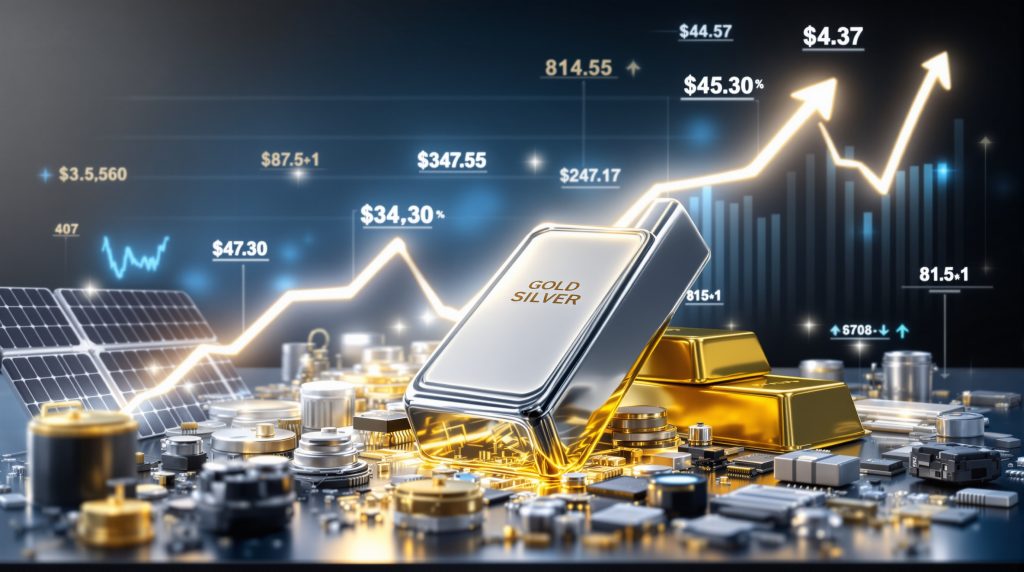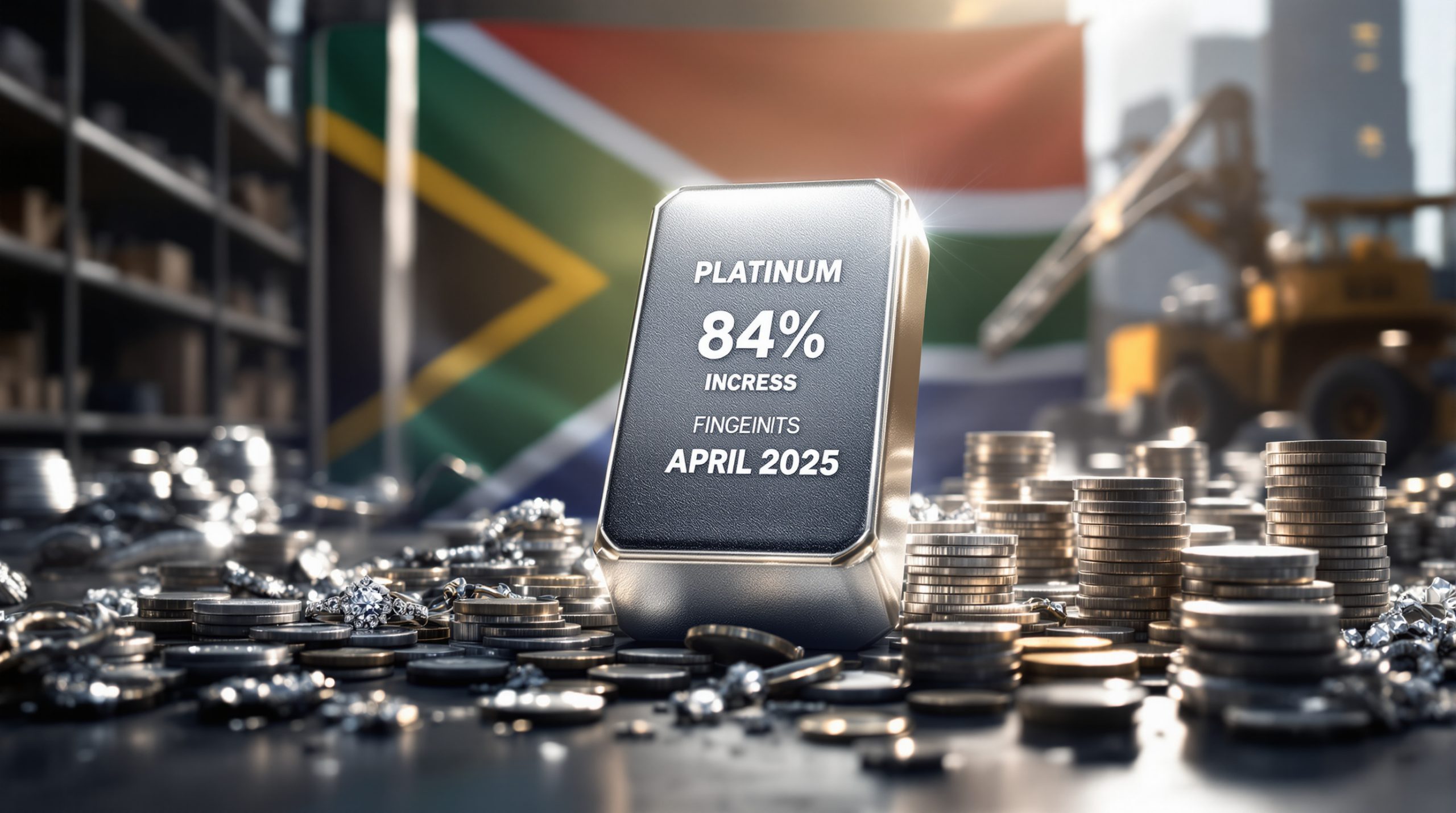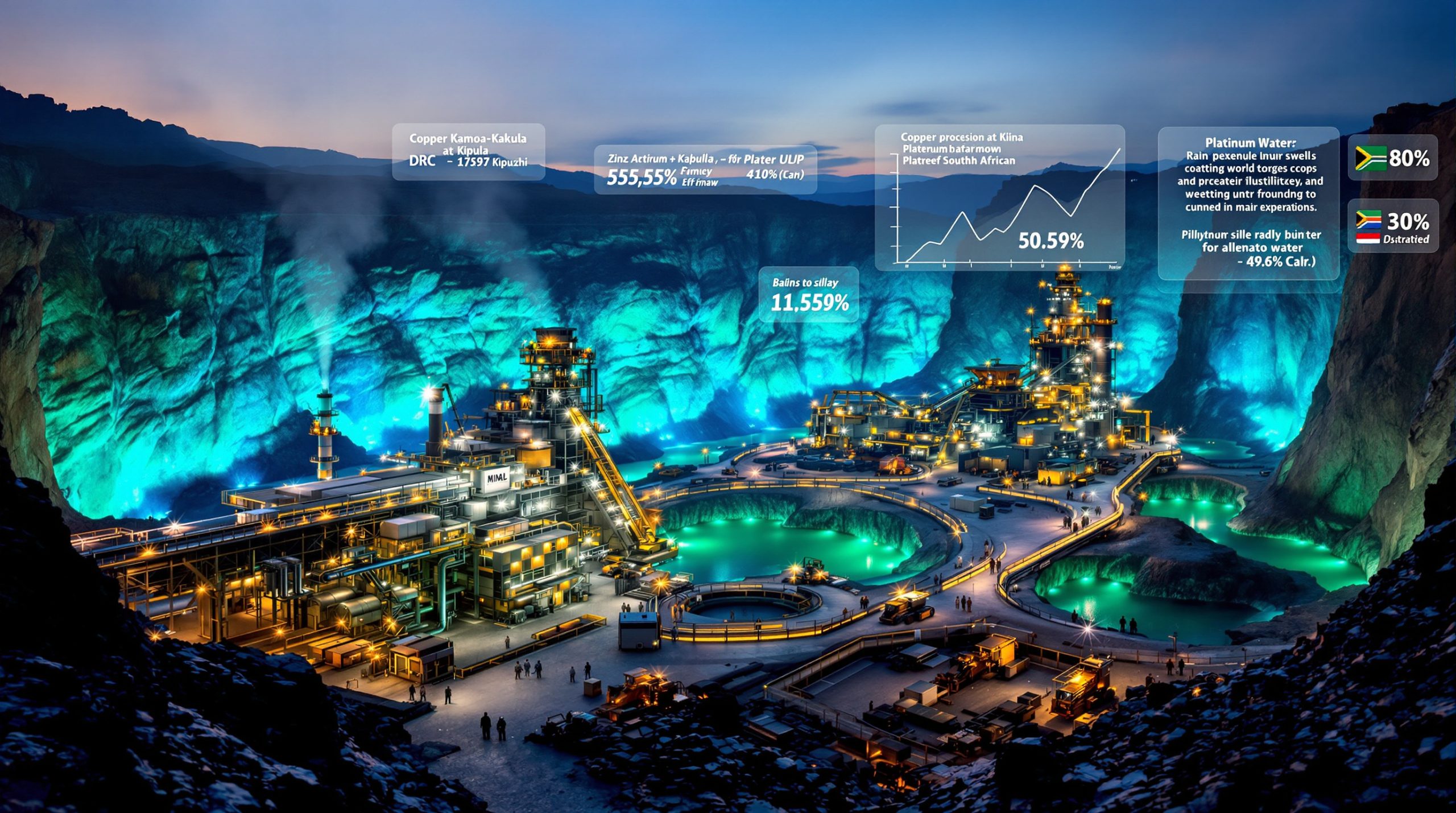Why Is Silver Suddenly Outperforming Gold in 2025?
Silver has dramatically surged past gold in recent months, capturing widespread investor attention with its impressive price action. Breaking through multi-decade resistance levels, silver has established itself as a standout performer in the precious metals sector, prompting questions about the sustainability and drivers behind this remarkable rally.
The Numbers Behind Silver's Meteoric Rise
Silver prices have shattered the psychological $47 barrier as of early October 2025, representing a staggering year-to-date increase exceeding 40%. This performance has significantly outpaced gold's more modest gains during the same timeframe. The gold-silver ratio insights previously reached an unsustainable peak of 104:1, has compressed to approximately 81.5:1, reflecting silver's accelerated momentum in the market.
The compression of this ratio indicates a significant shift in relative valuation between the two metals, with silver gaining ground against its more expensive counterpart. This ratio adjustment has been swift, highlighting the intensity of capital flows into the silver market throughout 2025.
Key Price Milestones in 2025
| Date | Silver Price (USD/oz) | Monthly Change | Notable Market Event |
|---|---|---|---|
| Early 2025 | $28.50 | – | Base for current rally |
| June 2025 | $34.75 | +12.3% | Industrial demand surge begins |
| September 2025 | $42.30 | +15.6% | Break above decade-long resistance |
| Early October 2025 | $47+ | +11.2% | Multi-decade high established |
The price progression reveals an accelerating trend, with silver breaking through multiple technical resistance points in rapid succession. Market analysts note that each breakthrough has been accompanied by increasing trading volumes, suggesting strong conviction behind the moves.
What's Driving Silver's Exceptional Performance?
Shifting Macroeconomic Landscape
The precious metals market has responded dramatically to several macroeconomic factors throughout 2025:
-
Robust Economic Growth: Contrary to earlier recession concerns, strong economic indicators have bolstered silver's industrial demand profile. The U.S. economy has shown particular resilience with GDP growth reaching 3.8% under the Trump administration, dispelling fears that previously held back silver's industrial component.
-
Monetary Policy Dynamics: Federal Reserve policy adjustments have created a favorable environment for precious metals. The September 2025 FOMC meeting became a pivotal moment for the market, with investors carefully watching for signals about future rate decisions.
-
Currency Market Volatility: Fiat currencies have experienced significant devaluation pressures, driving investors toward tangible assets. Market participants have increasingly questioned the stability of the global monetary system, creating strong tailwinds for both gold and silver.
-
Persistent Inflation Concerns: Despite official efforts to contain price increases, real-world inflation has continued to erode purchasing power, supporting precious metals as wealth preservation vehicles.
Market sentiment has shifted dramatically as recession fears have been "put on hold," allowing silver to break free from what some analysts describe as the "shackles" of its industrial component. This change in perception has been instrumental in allowing silver to catch up to gold's earlier gains.
The Industrial Demand Renaissance
Silver's unique position as both precious metal and industrial commodity creates distinctive market dynamics:
-
Green Energy Expansion: Solar panel manufacturing continues to consume substantial silver quantities, with each gigawatt of new capacity requiring approximately 20,000 kg of silver. The renewable energy sector's growth trajectory remains steep under various governmental mandates.
-
Electronic Component Growth: The technology sector's silver requirements have expanded with new device generations, particularly in high-conductivity applications where substitution remains challenging.
-
Automotive Industry Transformation: Electric vehicle production increases have boosted silver consumption in batteries, electrical systems, and autonomous driving components. The average EV contains about 25-50 grams of silver, roughly twice the amount in conventional vehicles.
-
Medical Applications: Healthcare sector silver usage has expanded significantly, leveraging silver's antimicrobial properties in specialized equipment, wound care, and biotechnology applications.
The industrial component of silver demand, once seen as a drag on performance during recession fears, has transformed into a powerful driver as economic confidence has improved through 2025.
Supply-Side Constraints
A critical factor supporting silver's price surge involves significant limitations in production capacity:
-
Production Deficits: Market analysts highlight persistent supply shortfalls relative to demand, with the deficit expected to continue through at least 2026.
-
Mining Challenges: Major silver-producing regions face operational and regulatory hurdles, including resource nationalism, environmental restrictions, and declining ore grades.
-
Exploration Shortfalls: Years of underinvestment in exploration have limited new supply pipelines. The capital expenditure drought from 2013-2022 has resulted in few major new silver discoveries reaching production.
-
Recycling Limitations: Secondary supply sources cannot fully address growing demand gaps, particularly as industrial applications often make recycling economically challenging.
Supply concerns have intensified with news of significant mining operations facing disruptions. Industry watchers have noted potential issues at major operations in Peru and elsewhere, contributing to market anxiety about future supply.
How Does Silver's Performance Compare to Other Assets?
Precious Metals Comparison
Silver's performance has diverged significantly from other precious metals in 2025:
-
Gold: While gold has maintained strength, trading at historically elevated levels, silver has demonstrated superior percentage gains. Gold highs analysis shows rise to approximately $3,850 per ounce represents impressive performance, but silver's percentage increase has been substantially greater.
-
Platinum/Palladium: Industrial precious metals have shown mixed performance compared to silver's consistent uptrend. Platinum has benefited from similar industrial tailwinds, while palladium has faced more challenging market conditions.
-
Historical Context: The current rally has characteristics distinct from previous bull markets in 2011 and 2020. While the 2011 surge was driven primarily by investment demand following the Global Financial Crisis, and 2020 saw pandemic-related supply disruptions, the current rally features a more balanced combination of investment and industrial demand.
The relationship between silver and other metals has shifted during this rally. Copper prices have shown strength, creeping back toward previous highs after temporary setbacks related to tariff adjustments. This base metal strength further supports silver's industrial narrative.
Broader Asset Class Performance
Within the global investment landscape, silver has emerged as a standout performer:
-
Equities: Silver has outperformed major stock indices on a percentage basis in 2025, providing investors with superior returns during a period of market volatility.
-
Fixed Income: Compared to bond markets, silver has provided superior returns amid changing interest rate environments. The declining real returns from fixed-income instruments have made precious metals more attractive by comparison.
-
Cryptocurrencies: Silver's performance has rivaled digital assets without the extreme volatility that has characterized crypto markets in recent years.
-
Real Estate: Precious metals have offered competitive returns versus property investments, particularly in regions experiencing affordability challenges and regulatory pressures.
The uranium sector has also seen renewed activity, with significant financing deals highlighting investor interest in the nuclear fuel cycle. One notable transaction involved nearly a billion dollars in bought-deal financing, coinciding with uranium prices exceeding $80 per pound.
What Does This Mean for Mining Equities?
Junior Mining Sector Renaissance
The silver price surge has revitalized the junior mining sector:
-
Financing Environment: Capital raising has accelerated dramatically, with many offerings oversubscribed multiple times. The enthusiasm has extended beyond precious metals, encompassing copper, uranium, and other minerals.
-
Year-to-Date Fundraising: By Q3 2025, the sector had already surpassed full-year totals from each of the previous three years (2022-2024). This acceleration points to a significant shift in investor sentiment toward resource companies.
-
Investor Sentiment: Generalist investors are returning to the mining space after years of absence, broadening the capital base beyond traditional resource-focused funds and retail investors.
-
Exploration Activity: Drilling programs and project advancements have accelerated significantly, reversing years of underinvestment in the exploration pipeline.
This financing renaissance represents a crucial turning point for the sector. After years of capital scarcity, exploration companies now have the resources to advance promising projects toward development decisions. Market participants note that while the pace has accelerated dramatically, the current environment still appears to be in the middle stages of a sector-wide bull cycle.
Major Producers Benefit
Established silver producers have seen substantial operational and financial improvements:
-
Margin Expansion: Higher silver prices have dramatically improved profitability metrics across the industry. Companies previously operating with tight margins have seen their financial situations transformed.
-
Balance Sheet Strengthening: Debt reduction and cash accumulation have enhanced financial flexibility, positioning companies for potential acquisitions or increased capital returns.
-
Dividend Increases: Several major producers have boosted shareholder returns, implementing or increasing dividend programs as cash flows improve.
-
Valuation Metrics: Despite price appreciation, many silver equities still trade at reasonable multiples, suggesting potential for further revaluation as the cycle progresses.
Industry experts note that the merger and acquisition cycle typically associated with bull markets has not yet accelerated significantly. This observation supports the view that the current bull market may still be in relatively early stages, perhaps the equivalent of "inning four" in baseball terms.
Is the Current Silver Rally Sustainable?
Bull Case Factors
Several elements support continued strength in silver prices:
-
Industrial Demand Trajectory: Green energy transition requirements continue to expand, with solar installations, electric vehicles, and advanced electronics creating persistent demand growth.
-
Investment Demand Growth: Retail and institutional interest remains robust, with silver benefiting from both monetary and industrial narratives. Physical silver products continue to command premiums in many markets.
-
Supply Constraints: Production challenges persist across major silver-producing regions. Notable disruptions at operations like Hudbay's Peruvian mine and potential issues at other major mines contribute to supply uncertainty.
-
Monetary Environment: Global currency dynamics favor precious metals allocation as central banks navigate complex policy decisions in an environment of persistent inflation pressures.
The fundamental supply-demand imbalance appears likely to persist through at least 2026, providing ongoing support for prices. With few major new mines scheduled to enter production, the supply response to higher prices will likely be delayed.
Potential Headwinds
Prudent investors should consider several risk factors:
-
Technical Resistance: Historical price points near $50/oz have previously triggered corrections. This level represents both psychological resistance and the area of previous all-time highs from 1980 and 2011.
-
Profit-Taking Pressure: Extended rallies often face selling from investors securing gains. After substantial price appreciation, this natural market behavior could create temporary pullbacks.
-
Economic Uncertainty: Any significant global economic slowdown could impact industrial demand, potentially removing a key pillar of support for the current rally.
-
Monetary Policy Shifts: Central bank actions remain a critical variable for precious metals. Market participants noted caution before the September 2025 Federal Reserve announcement, highlighting this sensitivity.
The pace of the rally itself has raised concerns among some market participants. Rapid price acceleration can sometimes indicate unstable market conditions or potential systemic issues developing behind the scenes, creating both opportunity and risk.
How Can Investors Approach the Silver Market?
Investment Vehicle Considerations
Multiple approaches exist for gaining silver exposure:
-
Physical Bullion: Direct ownership provides maximum security but requires storage solutions. Options include coins, bars, and allocated storage programs offered by reputable dealers.
-
ETFs and Funds: Exchange-traded products offer convenient exposure without physical handling. Major options include funds that hold physical metal in secure vaults, providing relatively direct price exposure.
-
Mining Equities: Producers and developers provide operational leverage to metal prices. Companies at different stages offer varying risk-reward profiles, from senior producers with diversified operations to single-asset developers.
-
Exploration Companies: Early-stage companies offer speculative upside but with higher risk. These ventures provide maximum leverage to discovery and resource expansion potential.
Each approach offers distinct advantages and considerations. Physical ownership eliminates counterparty risk but introduces storage and insurance considerations. Mining equities provide leverage but add operational, jurisdictional, and management risks to the investment equation.
Risk Management Strategies
Experienced market participants emphasize prudent approaches:
-
Position Sizing: Appropriate allocation sizing based on overall portfolio strategy remains essential, particularly for more volatile mining equities.
-
Profit-Taking Discipline: Systematic approaches to securing gains during extended rallies can protect capital while maintaining exposure. As one market expert noted, "Nobody's ever gone broke taking profits off the table."
-
Technical Analysis: Identifying key support and resistance levels for entry and exit points helps navigate volatility. The $50/oz level represents significant historical resistance worth monitoring.
-
Fundamental Monitoring: Tracking supply-demand metrics to validate investment theses ensures decisions remain grounded in market realities rather than speculation.
Given the substantial gains already realized, risk management becomes increasingly important. Market participants recommend taking partial profits on positions that have experienced extraordinary gains, while maintaining core exposure to the ongoing trend.
What's Next for Silver in 2025-2026?
Expert Projections
Market analysts offer varying perspectives on silver's trajectory:
-
Technical Targets: Chart patterns suggest potential moves toward $50-55/oz if momentum continues. Breaking above the all-time high near $50 would represent a significant technical achievement.
-
Supply-Demand Models: Fundamental analysis indicates sustained deficits supporting prices through at least 2026, with limited new supply coming online to address growing demand.
-
Cyclical Analysis: Historical patterns suggest the current bull cycle remains in middle stages. The absence of widespread merger and acquisition activity indicates room for further development.
-
Black Swan Considerations: Geopolitical or monetary system disruptions could accelerate price movements. Concerns about potential systemic challenges have contributed to the rapid price appreciation seen in 2025.
The coming months will likely provide greater clarity on whether silver can sustain its momentum. The approach toward historical resistance near $50/oz will represent a crucial test for market psychology and technical dynamics.
Key Indicators to Monitor
Investors should track several critical metrics:
-
ETF Flows: Investment product inflows/outflows provide sentiment indicators. Sustained inflows would suggest continued investment demand supporting prices.
-
CFTC Positioning: Futures market positioning reveals institutional sentiment. Extreme positioning can sometimes indicate potential turning points in the market.
-
Industrial Demand Data: Manufacturing and technology sector consumption trends offer insight into physical market fundamentals. Solar installation rates and EV production figures provide useful proxies.
-
Mine Supply Reports: Production figures from major silver-producing regions help assess supply responses to higher prices. Quarterly production reports from leading miners provide valuable data points.
Geopolitical developments also warrant close attention. Market participants have noted unusual developments, such as reports of Chinese gold vault construction in Saudi Arabia, that may signal important shifts in the global monetary landscape.
FAQs About Silver's Recent Performance
Why has silver suddenly outperformed gold in 2025?
Silver's recent strength stems from its dual nature as both monetary and industrial metal. While benefiting from the same safe-haven demand driving gold, silver has received additional support from robust industrial consumption, particularly in green energy, electronics, and automotive sectors. The previously high gold-silver ratio of 104:1 was widely viewed as unsustainable, creating conditions for silver to catch up through ratio compression to the current 81.5:1 level.
Is silver still undervalued compared to historical standards?
Despite reaching multi-decade highs, silver remains below its inflation-adjusted peak from 1980. The current gold-silver ratio of approximately 81.5:1 still exceeds the long-term historical average, suggesting potential for further relative appreciation. Additionally, persistent supply deficits and expanding industrial applications provide fundamental support for continued strength.
How are mining companies responding to higher silver prices?
The mining sector has experienced a dramatic renaissance, with financing activity in 2025 already exceeding full-year totals from 2022, 2023, and 2024. Many offerings are being oversubscribed multiple times, indicating robust investor interest. This capital influx is accelerating exploration and development activities, though new production remains constrained by permitting timelines and operational challenges.
What risks could derail the current silver rally?
Potential headwinds include technical resistance near the psychologically important $50/oz level, profit-taking from investors securing gains after substantial appreciation, economic slowdown impacting industrial demand, and unexpected monetary policy shifts. The silver market squeeze could also create additional volatility, while junior mining strategies and silver squeeze strategies become increasingly important for navigating this market environment.
Further Exploration:
Investors interested in deeper analysis of silver market dynamics can explore educational resources from reputable sources. The Soore Financial YouTube channel, hosted by Kai Hoffman, regularly features discussions on precious metals markets and mining sector developments, having grown to over 80,000 subscribers.
For those interested in direct industry engagement, the Deutsche Goldmesse (German Gold Fair) takes place November 14-15, 2025, in Frankfurt. This event brings together companies, analysts, and investors focused on the precious metals sector.
Disclaimer: This article contains forward-looking statements and market analysis. All investments involve risk, and past performance does not guarantee future results. Readers should conduct their own research and consult with financial advisors before making investment decisions.
Want to Spot the Next Major ASX Mining Discovery?
Discovery Alert's proprietary Discovery IQ model instantly notifies investors about significant mineral discoveries on the ASX, helping you identify promising opportunities before the broader market. Explore why major discoveries can generate substantial returns by visiting the dedicated discoveries page and position yourself for potential investment success.




